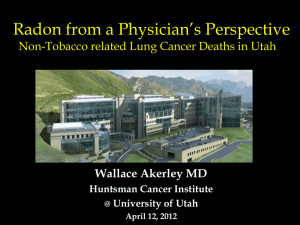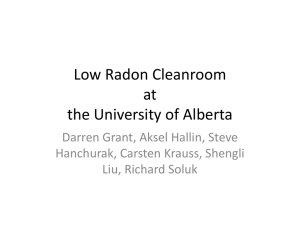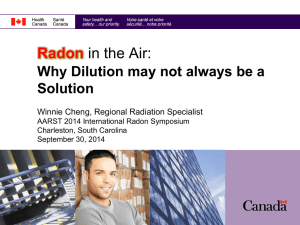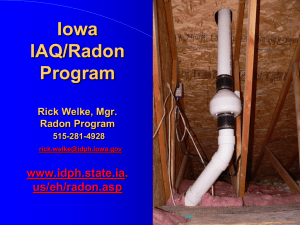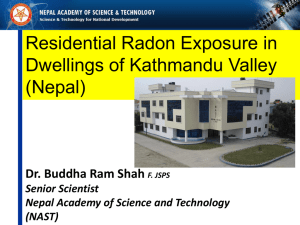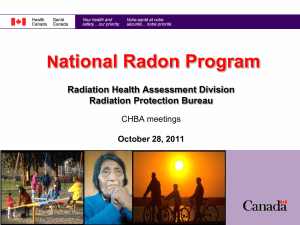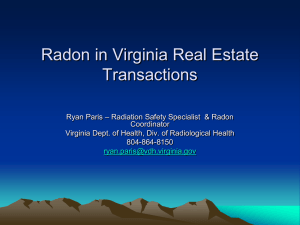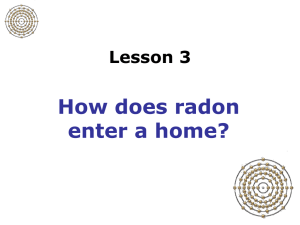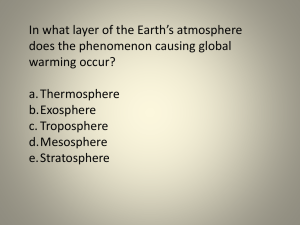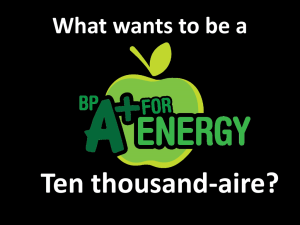View/Download the Radon in VA Real Estate
advertisement
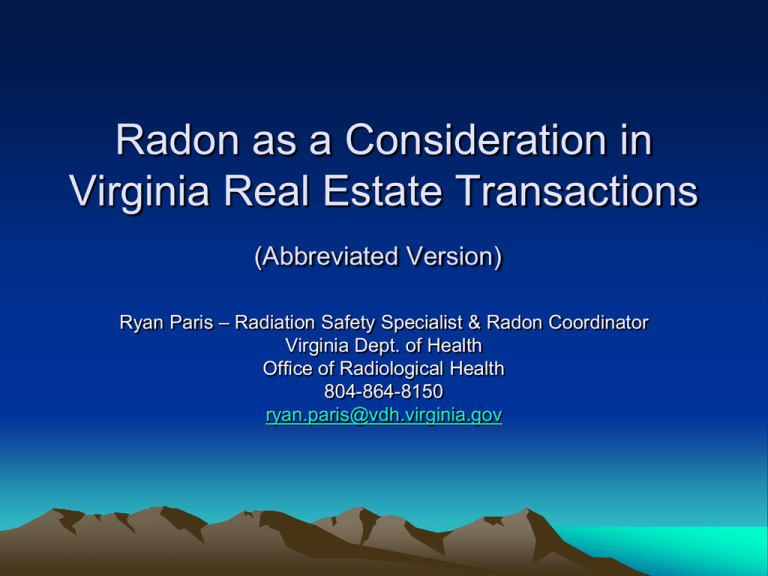
Radon as a Consideration in Virginia Real Estate Transactions (Abbreviated Version) Ryan Paris – Radiation Safety Specialist & Radon Coordinator Virginia Dept. of Health Office of Radiological Health 804-864-8150 ryan.paris@vdh.virginia.gov Radon…. • Is a naturally occurring radioactive decay product of Uranium & has a radioactive half-life of approx. 3.8 days • Tends to accumulate at higher concentrations in the lowest levels of the home – it’s progeny can also adhere to dust particles • Emits alpha particles which have limited range/penetrating power, but they can do great damage to lung tissue if inhaled You can find Radon... • In certain types of rocks, (in VA – mostly granite and shale) or associated soils & ground water • In the livable space of ANY type of home - whether it is built over a slab, basement or crawlspace. • But you cannot detect the presence of radon with your senses. • It has not been proven to cause allergic reactions or any other known physical symptoms other than an increased risk of lung cancer. How Does Radon get into the Home? Nearly 1 in 15 US homes is estimated to have elevated levels of radon. Where is the Greatest Radon Risk? • High levels of indoor Radon can be found in nearly every US state. • USEPA has classified all counties in USA as either High (Zone 1), Moderate (Zone 2) or Low (Zone 3) risk for Radon based on underlying geology and limited test data available in the early 1990’s. • VA has 46 high risk counties, 24 moderates and 26 at low risk. More recent testing data now indicates that this map probably needs some revision. • Testing your home is even MORE important if you live in a zone 1or 2 area and/or you spend most of your time on a level in contact with or below the ground USEPA Radon Zone Map for the Mid Atlantic States USEPA Recommends: • The only way to know your indoor radon level is to TEST! You cannot accurately predict a home’s radon level based on area risk or your neighbor’s results! • Radon is measured in pCi/l (pico curies per liter of air) The USEPA recommends fixing your home if the radon level is 4.0 pCi/L or higher. • No level of radon is absolutely “safe” - levels below 4 pCi/L still pose some risk! What do the test results mean? • Average US indoor radon levels ~ 1.3 pCi/L • Average US outdoor radon levels ~ 0.4 pCi/L • USEPA recommended indoor action level is 4.0 pCi/L or higher. Canada and many European countries now use 5.4 pCi/L • Typical post-mitigation radon levels average between 0.5 and 2.0 pCi/L. It is not possible to get indoor radon levels down to zero. Radon Lung Cancer Risk for a full lifetime (70 yr.) exposure: Radon is thought to be the second leading cause of lung cancer after smoking. It may cause as many as 21,000 lung cancer deaths/yr. in the USA – which includes approx. 670/yr. in Virginia! What are the chances of lung cancer? IF NEVER SMOKED: At 20 pCi/L: = 36/1000 At 10 pCi/L: = 18/1000 At 4 pCi/L: = 7/1000 At 1.3 pCi/L = 2/1000 CURRENT SMOKER: = 260/1000 = 150/1000 = 62/1000 = 20/1000 Radon and the Law in Virginia: • NO state or federal law currently REQUIRES radon testing prior to a sale nor does any law require mitigation if the radon levels are found to be elevated. It is entirely negotiable between the parties involved! • Real estate sales contract paperwork may include a radon test/mitigation contingency clause, but it does not technically have the rule of law supporting it. • VA law requires that all professional radon testers and mitigators operating in the Commonwealth must be currently certified and listed by either the NRPP or the NRSB. An expired certification is not acceptable! How to Test? • Certified professional radon testers may be found on the websites of the National Radon Proficiency Program (NRPP) (www.nrpp.info) or the National Radon Safety Board (NRSB) (www.nrsb.org) • For real estate transactions, it is recommended that a professional tester certified by either the NRPP or NRSB be used – do NOT let parties involved in the transaction conduct the testing themselves! • EPA recommends any one of these choices: – ONE short term (48 hr. minimum) continuous radon monitor (CRM) test – Or an average of TWO short term tests using other technologies – Or ONE long-term test (90 day minimum) General Radon Testing Guidelines: • For cases in which the seller still occupies the property, tamper resistant techniques should be used! • Avoid testing closets, storerooms, kitchens, bathrooms and crawlspaces. Bedrooms or family rooms are ideal. • Test devices should be placed in breathable air (3-6’ off floor is best) and not too close to walls or windows or other suspect areas (ex. sump pump or exposed soil) • Try to avoid testing during extended storms with high sustained winds and/or heavy precipitation Other Important Radon Testing Facts to Know: • Most homes test at their highest levels in the winter and lowest in the summer. Test results taken in the spring and fall (especially when exterior high temps. are 60-65 degrees) are usually closer to the year round average. • The highest radon levels are usually found in the lowest livable level of the home. There is typically a 25-50% reduction in radon levels between the basement and the first floor and then usually smaller reductions as you go up to additional floors. • A forced air HVAC system that draws its fresh air from the lowest level of the home will sometimes cause higher than expected radon levels in the upper floors. Radon Mitigation Piping Fan with coupling from PVC to gutter downspout piping Proper exterior riser pipe Interior piping schematic Radon in Water • Radon is usually only a potential problem in wells (ground water) • USEPA has yet to finalize ANY proposed health standards/recommendations/methods regarding radon in water! • The proposed USEPA radon in water standard may eventually be finalized at 4,000 pCi/L. NOTE: This would only apply to public water systems with at least 25 hook-ups – private individual wells would be exempt. • Radon in water poses a comparatively insignificant ingestion risk but radon in water can evaporate into the air when the water is agitated (showers faucets, dish/clothes washers) • 10,000 pCi/L in water is thought to contribute 1 pCi/L to indoor radon air levels • Mitigating a home’s water with best available technology may cost up to $4000-5000! Radon in Granite Counter Tops: • Many types of granite are naturally radioactive and some may emit small amounts of radon, but the vast majority of granite slabs are NOT significant contributors to indoor Radon levels • Many sensationalistic TV/newspaper reports inaccurately publicized the results of inappropriate testing methods (ex. a Geiger counter measures gamma NOT alpha radiation!) • You cannot accurately predict granite radon risk based on color or country of origin • If you are concerned, test the breathable air above the slab, NOT on the slab itself and follow all normal short-term testing procedures (ex. do not run kitchen exhaust fans!) and compare to a short-term test done in the lowest level of the home • Many granite vendors are now pre-screening and pulling slabs that emit excessive radioactivity. Further Information • Va. Dept. of Health – Office of Radiological Health: 804-864-8150 • Free USEPA Radon publications: www.epa.gov/radon/pubs Get: - “Home Buyer’s & Seller’s Guide to Radon” - “Consumer’s Guide to Radon Reduction” - ASTM E2121-12 which is the current EPA & VA standard for radon mitigation • 1-800-SOS Radon • National Safety Council 1-800-55RADON • Spanish 1-800-725-8312 • Safe Drinking Water Hotline 1-800-426-4791
